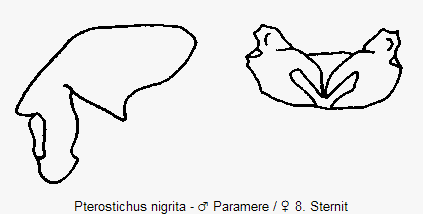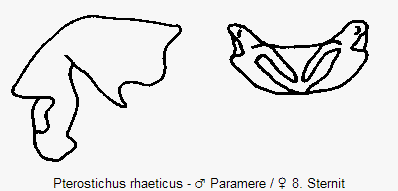
Pterostichus nigrita (Paykull, 1790)
Pterostichus rhaeticus Heer, 1837
Suborder:
Family:
Subfamily:
Tribe:
Genus:
Subgenus:
ADEPHAGA Clairville, 1806
PTEROSTICHINI Bonelli, 1810
Pseudomaseus Chaudoir, 1838
Only recently understood to be distinct species (Luff, 1990); P. rhaeticus was formerly included with P. nigrita and the two are treated together in older (pre-1990) literature. Both are widespread and common and they seem to overlap in their ecological requirements, and so will often occur in similar situations at the same site. They are very similar morphologically but may be determined by dissection, although beyond the UK this is not always reliable as there may be some overlap in the features (Angus et al 2009). The following description will separated both from our other ground beetles. 9.0-12.5 mm. (P. nigrita on average a little larger) Body and appendages glabrous and shiny black (specimens of nigrita with reddish femora and elytral apices (var. rufofemoratus) occur very rarely in Ireland). Head smooth between convex and protruding eyes, frontal furrows long but usually weakly impressed, two setiferous punctures besides each eye. Antennae pubescent from third segment, basal segment about as long as the third segment and not keeled dorsally (cf. Poecilus). Mandibles sharp, symmetrical, the outer margin without a setiferous puncture, apical maxillary palpomere well-developed, penultimate labial palpomere with at most two setae on the inner margin. Pronotum characteristic; lateral margin smoothly rounded to distinctly toothed posterior angles, anterior angles obtusely angled or rounded, at most only slightly protruding, basal fovea doubled and punctured; the inner not extending onto the disc and the outer delimited externally by a short keel. Elytra with rounded shoulders and a complete basal margin, striae, including a short scutellary striole, well-impressed, interstices weakly convex (the seventh interstice simply convex behind the shoulders) and with fine reticulate microsculpture, the third usually with three non-foveate punctures, the posterior puncture well removed from the apex. Epipleurs crossed before the apex. Front tibiae strongly broadened beyond the internal antenna-cleaning notch, all tibiae with a strong apical spur shorter than the first tarsomere. Terminal tarsomere glabrous ventrally. Basal segments of front tarsi dilated in males.
The only way to be certain of the identification is to examine the male genitalia or the eighth sternite of the female abdomen. The genitalia are heavily sclerotized and straightforward to remove; with a little teasing the parameres will come free and they retain their shape when dry and can be mounted with the specimen. Female ventrites can be delicate and care must be taken to avoid tearing. The right paramere of nigrita is larger apically and has a shallow lateral incision whereas in rhaeticus it is more pointed apically and more deeply incised laterally (these features vary but are usually obvious). The left paramere is very different and not diagnostic. In female nigrita the eighth sternite is much broader when compared with rhaeticus. Below images provided by Arved Lompe:


Pterostichus nigrita
A Palaearctic-wide species extending from Europe and Asia Minor to the far east of Russia and Japan, also known from most of the Mediterranean islands and North Africa, it is generally common and often abundant throughout Europe from lowlands to lower mountain altitudes (to about 1500 m.) to the far north of Fennoscandia and is present on the Faroe Islands and Iceland. In the UK it is common throughout England and Wales and rather less so in Scotland, including the Western Isles and Orkney, and across Ireland. The species is hygrophilic and widely eurytopic and so should be expected from wetland margins, marshes and drainage ditches etc., it also occurs on damp grassland, heaths, moors and woodland and may be abundant on arable margins, parkland and even domestic gardens, usually in shaded situations and often on heavy or slightly acid soils. Most specimens have fully-developed wings and disperse by flight, but on the continent there is a continuous range of wing development and macropterous populations on floodplains etc. are known to migrate to overwintering sites by walking. Adults occur year-round, they overwinter in tussocks or among moss etc. and are active over a long season from March until late in the autumn, peaking in abundance during late spring or early summer. Breeding occurs in the spring; females oviposit in the soil or under debris and each may produce up to twenty eggs. Larvae emerge after about two weeks develop through the spring and early summer, they are ground dwelling and exclusively predatory, feeding on live insects and their larvae, proving to be cannibalistic under artificial conditions, and ignoring dead insects, earthworms, molluscs and carrion etc. Pupation occurs during the summer, this stage lasts about two weeks and new-generation adults appear from late summer. These new adults will become active and feed but they will not be sexually mature until the following spring. Adults are mostly crepuscular and nocturnal and may be seen active on the ground at night, they otherwise remain under debris or among litter etc., during the winter they are easily found by searching under debris in sheltered sites but they usually occur as single specimens or in small groups.
Pterostichus rhaeticus
Only recently separated from P. nigrita and so the distribution is not fully understood, but the species is widespread across the Western Palaearctic region as far east as the Urals, and is also known from the far east of Russia and Japan, it is yet not recorded from the Mediterranean islands or North Africa but is widespread and common in Europe to the far north of Fennoscandia and is also known from Faroe and Iceland. In the U it is generally common throughout, including all the islands north to Shetland and in Northern Ireland, and rather more scattered and local across the south Ireland. Adults are present year-round; they are active from March until October or November and peak in abundance during May and June. Typical habitats overlap with the previous species; it is equally common in wetland situations, damp grassland, parkland and arable land etc. but also occurs in more acid conditions on moorland and is often common in bogs and peaty areas. Thus there may be some degree of specialization but in general both are likely to occur, and sometimes together, in a wide range of situations. The biology is not yet understood but they seem to have smaller wings than nigrita and they do not fly, they are crepuscular and nocturnal and are thought to be spring breeders with a similar development to that species. They may be sampled in much the same way as nigrita, but nocturnal searching or by looking under debris or matted vegetation by day; they overwinter in sheltered sites away from their summer habitats and become active early in the year, often during mild winter spells.